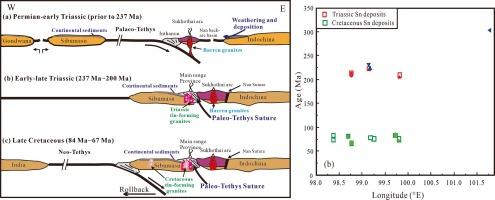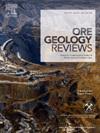Cassiterite and zircon U-Pb ages and compositions from ore-bearing and barren granites in Thailand: Constraints on the formation of tin deposits in Southeast Asia
IF 3.2
2区 地球科学
Q1 GEOLOGY
引用次数: 0
Abstract
The Southeast Asian Tin Province comprises western, central, and eastern belts and hosts significant granite-related Sn deposits. The genetic links between granites and Sn mineralization are still unclear. Most Sn deposits are in Thailand’s western and central belts, but their origin remains poorly elucidated due to the absence of direct dating of mineralization. Herein in-situ U-Pb age data of wolframite and cassiterite grains from nine representative Sn deposits in Thailand are obtained, which fall into two stages. Triassic deposits (224–210 Ma) are found in the Central belt, with Cretaceous deposits (78–67 Ma) in the Central belt being younger than those in the Western belt (84–74 Ma). However, ore-bearing granites, spanning two periods (227–205 Ma and 85–69 Ma), occur in central and western belts. Some Triassic ore-bearing granites exhibit significantly older ages than ore-forming ages. Newly identified ore-forming granites contain zircon grains with relatively low εHf(t) values (−29.5 to + 4.1; average = − 11.8), indicative of an origin from supracrustal sediments from the Sibumasu block. In contrast, barren granites have ages from 303–224 Ma and higher zircon εHf(t) values (−9.9 to + 13.2; average = +1.2), which suggests that they were derived from the juvenile mafic crust. Even after experiencing hydrothermal fluids exsolution, some low-fractionated ore-forming granites (D.I. < 90) still maintain remarkably high tin contents. Both ore-forming and barren granites crystallized under reducing conditions. Our study highlights the importance of Sn-rich sources of parental magmas in forming Sn deposits. The metasediment-rich basement of the Sibumasu block distributing along the continental margin is likely the Sn-rich source. These sources played a crucial role in forming two stages of tin deposits in distinct tectonic settings, that are syn-collisional crustal thickening in Paleo-Tethys and post-collisional extension-related settings in Neo-Tethys.

泰国含矿花岗岩和贫瘠花岗岩的锡石和锆石U-Pb年龄和成分:东南亚锡矿床形成的制约因素
东南亚锡矿省由西部、中部和东部矿带组成,拥有大量与花岗岩有关的锡矿床。花岗岩与锡矿化之间的成因联系尚不清楚。大多数锡矿床位于泰国的西部和中部矿带,但由于缺乏直接的成矿年代测定,其成因仍未得到很好的阐明。本文获得了泰国九个代表性锡矿床的黑钨矿和锡石晶粒的原位 U-Pb 年龄数据,这些矿床分为两个阶段。三叠纪矿床(224-210Ma)分布在中部矿带,中部矿带的白垩纪矿床(78-67Ma)比西部矿带的白垩纪矿床(84-74Ma)年轻。然而,含矿花岗岩跨越两个时期(227-205 Ma 和 85-69 Ma),出现在中部和西部岩带。一些三叠纪含矿花岗岩的年龄明显早于成矿年龄。新发现的成矿花岗岩含有εHf(t)值相对较低的锆石颗粒(-29.5 至 + 4.1;平均值 = -11.8),表明其起源于锡布马苏块体的上壳沉积物。相比之下,贫瘠花岗岩的年龄为303-224Ma,锆石εHf(t)值较高(-9.9至+13.2;平均值=+1.2),这表明它们源自幼年黑云母地壳。即使经历了热液的溶解,一些低分馏成矿花岗岩(D.I. <90)仍然保持着极高的锡含量。成矿花岗岩和贫瘠花岗岩都是在还原条件下结晶的。我们的研究突出了母岩浆中富锡来源对形成锡矿床的重要性。沿大陆边缘分布的锡布马苏块体富含玄武岩的基底可能是富含锡的来源。这些来源在不同构造背景下形成锡矿床的两个阶段中发挥了关键作用,这两个阶段分别是古特提斯的同步碰撞地壳增厚和新特提斯的碰撞后延伸相关背景。
本文章由计算机程序翻译,如有差异,请以英文原文为准。
求助全文
约1分钟内获得全文
求助全文
来源期刊

Ore Geology Reviews
地学-地质学
CiteScore
6.50
自引率
27.30%
发文量
546
审稿时长
22.9 weeks
期刊介绍:
Ore Geology Reviews aims to familiarize all earth scientists with recent advances in a number of interconnected disciplines related to the study of, and search for, ore deposits. The reviews range from brief to longer contributions, but the journal preferentially publishes manuscripts that fill the niche between the commonly shorter journal articles and the comprehensive book coverages, and thus has a special appeal to many authors and readers.
 求助内容:
求助内容: 应助结果提醒方式:
应助结果提醒方式:


